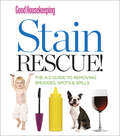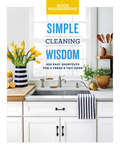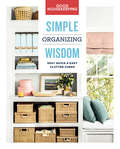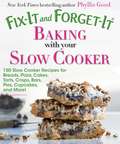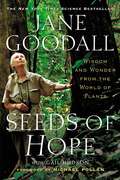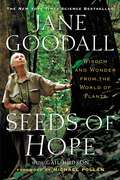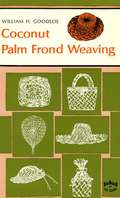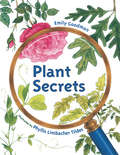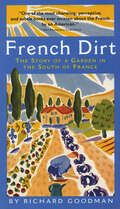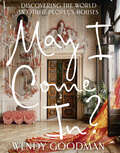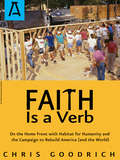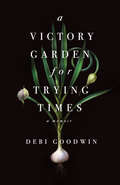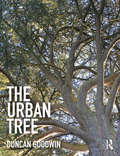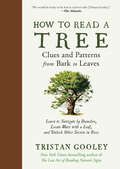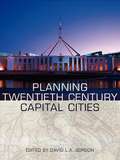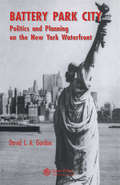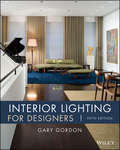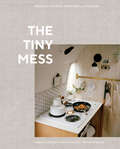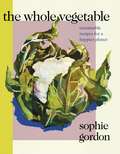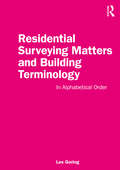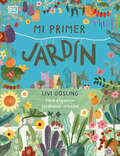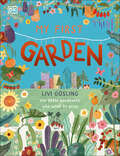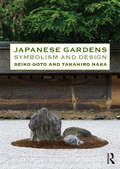- Table View
- List View
Stain Rescue!: The A-Z Guide to Removing Smudges, Spots & Spills (Good Housekeeping Cookbooks)
by Good HousekeepingFrom America’s iconic lifestyle magazine, easy-to-follow instructions for cleaning a multitude of stains from clothing, furniture and more—includes photos.Get that ketchup off your shirt and the crayon out of your couch with this ultimate A–Z stain-removal guide from the experts at The Good Housekeeping Institute. Now with a vibrant new design and photography, Stain Rescue reveals how to remove hundreds of stains from fabric, upholstery, and carpeting—quickly and easily. Organized by type of stain, this handy guide provides information on bleach, tools, and must-have products; mystery stains, stain prevention, and treating and storing heirloom textiles. You'll even see how to remove the top ten kid stains!
Simple Cleaning Wisdom: 450 Easy Shortcuts for a Fresh & Tidy Home (Simple Wisdom #2)
by Good Housekeeping Carolyn ForteThis Good Housekeeping guide is so simple and smart it will make you WANT to clean! Get a sparkling home in a snap! Whether you’re a cleaning enthusiast or a procrastinator, you’re in luck, because no one knows how to keep a home fresh and tidy like the experts at Good Housekeeping. This room-by-room guide is jam-packed with time-saving advice, including information on hardworking Good Housekeeping Institute Lab-tested products. It features a must-have section on stain removal (a perennial request from the magazine’s millions of readers) as well as welcome advice on cleaning up after Fido and after the kids. Hundreds of tricks and tips for taking care of everything from grease stains to kitchen odors, laundry mishaps, and carpet catastrophes will help you clean faster, declutter more easily, tackle trouble spots, simplify big jobs, and accomplish more in less time. Good Housekeeping Simple Cleaning Wisdom reveals:“Pillow talk” on choosing the right one, when to replace it, and how to protect it against allergensHow to fix laundry disasters—including when colors from one garment bleed onto anotherThree mistakes that ruin woodPatio, porch, and deck spruce ups, plus ideas to keep your grill sizzling (hint: ditch the wire brush)How to put a stop to mold and mildewHow to freshen up a guest room . . . fast—and speed clean in the house in minutes
Simple Organizing Wisdom: 500+ Quick & Easy Clutter Cures (Simple Wisdom #3)
by Good Housekeeping Laurie JenningsFrom America’s iconic lifestyle magazine, a guide to decluttering, maximizing space and storage and simplifying household tasks—includes photos. Let the experts at Good Housekeeping help you get organized with this inspirational room-by-room guide to tidying up! Hundreds of tips and tricks include how to keep a well-ordered fridge, gain extra counter space, conquer cookware clutter, choose the best shelving, clear up your desk and digital spaces, and streamline your closet and garage. You’ll find pro organizer ideas for every area in your home, must-have Good Housekeeping Institute-approved products, and advice on finding a place for everything and putting everything in its place. Keep this book handy, refer to it often, and say goodbye to the mess!
Fix-It and Forget-It Baking with Your Slow Cooker: 150 Slow Cooker Recipes for Breads, Pizza, Cakes, Tarts, Crisps, Bars, Pies, Cupcakes, and More! (Fix-It and Forget-It)
by Phyllis GoodYou knew that slow cookers make delicious soups and stews, but did you know that they also make soft and chewy cookies, gooey bars, fluffy cakes, and moist breads? The beloved Fix-It and Forget-It series has sold nearly eleven million copies, giving home cooks around the world exactly what they crave--recipes for delicious, satisfying meals that anyone can make with simple ingredients and minimal preparation time. Now, New York Times-bestselling author Phyllis Good presents a collection that gives cooks an unexpected treat--fabulous baked goods! Featuring 250 new, mouthwatering recipes--all carefully tested--this will be the go-to book for bake sales, last-minute guests, holiday baking, and everyday treats! Fix-It and Forget-It Baking with Your Slow Cooker is a big, full-color, useful cookbook that, in addition to recipes, offers tips and tricks for baking with your slow cooker, FAQs, suggestions for substituting common allergen ingredients, and more.
Seeds of Hope
by Jane Goodall Gail HudsonRenowned naturalist and bestselling author Jane Goodall examines the critical role that trees and plants play in our world. In her wise and elegant new book, Jane Goodall blends her experience in nature with her enthusiasm for botany to give readers a deeper understanding of the world around us.Long before her work with chimpanzees, Goodall's passion for the natural world sprouted in the backyard of her childhood home in England, where she climbed her beech tree and made elderberry wine with her grandmother. The garden her family began then, she continues to enjoy today. SEEDS OF HOPE takes us from England to Goodall's home-away-from-home in Africa, deep inside the Gombe forest, where she and the chimpanzees are enchanted by the fig and plum trees they encounter. She introduces us to botanists around the world, as well as places where hope for plants can be found, such as The Millennium Seed Bank, where one billion seeds are preserved. She shows us the secret world of plants with all their mysteries and potential for healing our bodies as well as Planet Earth.Looking at the world as an adventurer, scientist, and devotee of sustainable foods and gardening-and setting forth simple goals we can all take to protect the plants around us-Jane Goodall delivers an enlightening story of the wonders we can find in our own backyards.
Seeds of Hope: Wisdom and Wonder from the World of Plants
by Jane Goodall Michael Pollan Gail HudsonRenowned naturalist and bestselling author Jane Goodall examines the critical role that trees and plants play in our world. In her wise and elegant new book, Jane Goodall blends her experience in nature with her enthusiasm for botany to give readers a deeper understanding of the world around us.Long before her work with chimpanzees, Goodall's passion for the natural world sprouted in the backyard of her childhood home in England, where she climbed her beech tree and made elderberry wine with her grandmother. The garden her family began then, she continues to enjoy today. SEEDS OF HOPE takes us from England to Goodall's home-away-from-home in Africa, deep inside the Gombe forest, where she and the chimpanzees are enchanted by the fig and plum trees they encounter. She introduces us to botanists around the world, as well as places where hope for plants can be found, such as The Millennium Seed Bank, where one billion seeds are preserved. She shows us the secret world of plants with all their mysteries and potential for healing our bodies as well as Planet Earth.Looking at the world as an adventurer, scientist, and devotee of sustainable foods and gardening-and setting forth simple goals we can all take to protect the plants around us-Jane Goodall delivers an enlightening story of the wonders we can find in our own backyards.
Coconut Palm Frond Weaving
by William H. Goodloe Ellen GoodloeLearn the art of palm weaving with this fun Hawaiian craft book.Based on years of meticulous study and practice, the book explains in clear, easy-to understand instructions how to obtain and prepare coconut palm fronds suitable for weaving into hats, baskets, epergnes, mats, birds, and various decorations. More than 100 easy-to-follow diagrams and sketches give the reader exact, detailed instructions on weaving procedures, and provide countless ideas to inspire the imagination of the creator. After mastering the basic principles of frond weaving, the reader will be able to duplicate almost any woven object or execute his own designs, whether in coconut palm fronds or with fronds from other types of palm trees and palmettos.The weaving itself takes no unusual physical prowess. In fact, frond weaving is well suited to the needs of both recreational craft and physical therapy programs, as well as the general hobbyist. With a little patience and effort, a novice weaver can acquire the skills of an ancient art which is as uncomplicated as it is beautiful.This economical and delightfully presented volume will be a valued addition to the literature of traditional handicrafts, a book that recreation libraries and all craft enthusiasts will welcome.
Plant Secrets
by Emily GoodmanYoung scientists will love this nature mystery that reveals the secrets hiding in seeds, plants, flowers, and fruits throughout the life cycle of various flora. Curiosity will bloom in this introduction to botany and primary nature science. Plants come in all shapes and sizes, but they go through the same stages as they grow. Using four common plants, young readers learn about plant structure and life cycle. Simple text and colorful, detailed illustrations show the major phases of plant growth with each stage holding a &“secret&” for curious readers to guess. Back matter offers more information on each plant, as well as greater detail on each stage of growth.
French Dirt: The Story of a Garden in the South of France
by Richard GoodmanA story about dirt--and about sun, water, work, elation, and defeat. And about the sublime pleasure of having a little piece of French land all to oneself to till. Richard Goodman saw the ad in the paper: "SOUTHERN FRANCE: Stone house in Village near Nimes/Avignon/Uzes. 4 BR, 2 baths, fireplace, books, desk, bikes. Perfect for writing, painting, exploring & experiencing la France profonde. $450 mo. plus utilities." And, with his girlfriend, he left New York City to spend a year in Southern France. The village was small--no shops, no gas station, no post office, only a café and a school. St. Sebastien de Caisson was home to farmers and vintners. Every evening Goodman watched the villagers congregate and longed to be a part of their camaraderie. But they weren't interested in him: he was just another American, come to visit and soon to leave. So Goodman laced up his work boots and ventured out into the vineyards to work among them. He met them first as a hired worker, and then as a farmer of his own small plot of land. French Dirt is a love story between a man and his garden. It's about plowing, planting, watering, and tending. It's about cabbage, tomatoes, parsley, and eggplant. Most of all, it's about the growing friendship between an American outsider and a close-knit community of French farmers. "There's a genuine sweetness about the way the cucumbers and tomatoes bridge the divide of nationality."--The New York Times Book Review "One of the most charming, perceptive and subtle books ever written about the French by an American."--San Francisco Chronicle
May I Come In?: Discovering the World in Other People's Houses
by Wendy GoodmanNew York magazine&’s interiors editor shares some of her most memorable house profiles in this stunning and inspiring visual tour. For May I Come In?, design editor extraordinaire Wendy Goodman visits seventy homes that express their owners&’ spirit and passions. In this pantheon, imagination and originality hold sway: Artists and eccentrics are the equals of aristocrats and the mandarins of design. Alba Clemente&’s closet is a Renaissance theater; Amy Sedaris built a playroom (but not for children); Andrew Solomon houses his guests in an igloo; Richard Avedon&’s private walls were bulletin boards; Kathy Ruttenberg&’s house is an animal kingdom; Jay Maisel called a former bank with seventy-two rooms home. Every room has a story to tell and a purpose for being. A self-described design hunter, Goodman spent thirty years seeking extraordinary living spaces. In her long career, she has found three things to be true. The first is that curiosity and never giving up will get you everywhere. The second is what Diana Vreeland stated best when she wrote, &“Few things are more fascinating than the opportunity to see how other people live during private hours.&” The third is that houses never lie. These principles underscore her search for individuality, human interest, and authenticity in design.May I Come In? is profusely illustrated with superb images by leading interior photographers, as well as Goodman&’s own snapshots and memorabilia related to her quests. It is an irresistible visual record of the art of living by one of its most astute observers.&“Page after page reveals interiors that practically vibrate with charisma, while others wax a poetic minimalism that, despite a lack of things, overwhelm with grace.&” —Vogue &“When it comes to the New York design scene, Wendy Goodman is positively an institution.&” —Town & Country
Faith Is a Verb: On the Home Front with Habitat for Humanity and the Campaign to Rebuild America (and the World)
by Chris GoodrichFaith is a Verb is both an account of the author's five years volunteering with Habitat for Humanity and a history of the organization, which Goodrich sees as a model institution founded on grassroots, Jeffersonian principles. The reader looks over his shoulder as Goodrich helps restore a burned-out drug den to its Victorian glory in Bridgeport, Connecticut; understands the yawning gap between the rich and poor as he straightens nails with an impoverished teenager in the Dominican Republic; senses the importance of volunteer work as he watches, while laying a stone foundation in Paraguay, the Twin Towers fall on 9/11.Goodrich traces Habitat's history back to an unsung American hero, Clarence Jordan, who in the 1940's founded a Christian community in Georgia, Koinonia Farm, dedicated to social and economic justice. Millard Fuller, a millionaire businessman, visited at Koinonia in the early 1970's, and under Jordan's guidance realized he was a "money-holic," gave away his fortune, and in 1976 founded Habitat for Humanity. Goodrich shows how Fuller's Southern Baptist, Friday-night-revival personality helped turn Habitat into the world's largest non-governmental home-builder, his inspirational leadership greatly abetted by the support of former president Jimmy Carter. In a postscript the author describes the crisis Habitat faced when Fuller was forced out following allegations of sexual harassment in 2005. This edition updates the story to 2013, when the organization had "helped build or repair more than 600,000 houses" world-wide.What readers have said about Faith is a Verb:"A great record of how [Habitat for Humanity] got underway and became so significant." -- Tony Campolo, PhD., author of Pray Give Go Do"[S]pirited and intimate....Anyone interested in learning about or volunteering for the organization will find his account richly detailed." -- David Bornstein, author of How to Change the World
A Victory Garden for Trying Times
by Debi Goodwin“A compelling and intimate reflection on love and grief and ordinary things that comfort and sustain us.” — Alison Smith, award-winning journalist Ever since her childhood on a Niagara farm, Debi has dug in the dirt to find resilience. But when her husband, Peter, was diagnosed with cancer in November, it was too late in the season to seek solace in her garden. With idle hands and a fearful mind, she sought something to sustain her through the months ahead. She soon came across Victory Gardens — the vegetable gardens cultivated during the world wars that sustained so many. During an anxious winter, she researched, drew plans, and ordered seeds. In spring, with Peter in remission, her garden thrived and life got back on track. But when Peter's cancer returned like a killing frost, the garden was a reminder that everything must come to an end. A Victory Garden for Trying Times is a personal journey of love, loss, and healing through the natural cycles of the earth.
The Urban Tree
by Duncan GoodwinThere is a growing evidence base that documents the social, environmental and economic benefits that urban trees can deliver. Trees are, however, under threat today as never before due to competition for space imposed by development, other hard infrastructures, increased pressure on the availability of financial provision from local authorities and a highly cautious approach to risk management in a modern litigious society. It is, therefore, incumbent upon all of us in construction and urban design disciplines to pursue a set of goals that not only preserve existing trees where we can, but also ensure that new plantings are appropriately specified and detailed to enable their successful establishment and growth to productive maturity. Aimed at developers, urban planners, urban designers, landscape architects and arboriculturists, this book takes a candid look at the benefits that trees provide alongside the threats that are eliminating them from our towns and cities. It takes a simple, applied approach that explores a combination of science and practical experience to help ensure a pragmatic and reasoned approach to decision-making in terms of tree selection, specification, placement and establishment. In this way, trees can successfully be incorporated within our urban landscapes, so that we can continue to reap the benefits they provide.
How to Read a Tree: Clues And Patterns From Bark To Leaves (Natural Navigation #0)
by Tristan Gooley“Reams of appealing facts make one itch to get outside and right up close to trees’ rough surfaces and shady cover.”—The Atlantic New York Times–bestselling author Tristan Gooley opens our eyes to the secret language of trees—and the natural wonders they reveal all around us Trees are keen to tell us so much. They’ll tell us about the land, the water, the people, the animals, the weather, and time. And they will tell us about their lives, the good bits and bad. Trees tell a story, but only to those who know how to read it. In How to Read a Tree, Gooley uncovers the clues hiding in plain sight: in a tree’s branches and leaves; its bark, buds, and flowers; even its stump. Leaves with a pale, central streak mean that water is nearby. Young, low-growing branches show that a tree is struggling. And reddish or purple bark signals new growth. Like snowflakes, no two trees are exactly the same. Every difference reveals the epic story this tree has lived—if we stop to look closely.
Advances in Physical Ergonomics and Human Factors: Proceedings of the AHFE 2016 International Conference on Physical Ergonomics and Human Factors, July 27-31, 2016, Walt Disney World®, Florida, USA (Advances in Intelligent Systems and Computing #489)
by Ravindra Goonetilleke Waldemar KarwowskiTaking the field of human factors and ergonomics beyond state of the art, this volume focuses on advances in the use of ergonomics modeling and on the evaluation of usability, which is a critical aspect of any human-technology system. The research described in the book's 70 chapters is an outcome of dedicated research by academics and practitioners from around the world, and across disciplines. The chapters are organized under five sections: I. Models and Methods II. Vision and Visual Displays , III. Product Design and User Interfaces IV. Input Devices and Computer Based Systems V. Individual and Environmental Technology Related Issues. This work provides an invaluable resource for evaluating products and environments and designing future ones that are intuitive, safe, and easy to use. Seven other titles in the Advances in Human Factors and Ergonomics Series are: Advances in Human Factors and Ergonomics in Healthcare Advances in Applied Digital Human Modeling Advances in Cross-Cultural Decision Making Advances in Cognitive Ergonomics Advances in Occupational, Social and Organizational Ergonomics Advances in Human Factors, Ergonomics and Safety in Manufacturing and Service Industries Advances in Neuroergonomics and Human Factors of Special Populations
How to Window Box: Small-space Plants To Grow Indoors Or Out
by Chantal Aida Gordon Ryan BenoitFrom the founders of the popular gardening blog The Horticult comes a guide to the window box, the container garden that is by far the most accessible garden for any skill level, space, or quality of light. The sixteen indoor and outdoor projects range from succulents to veggies and showcase a variety of full sun- and shade-loving foliage. Bright photography and a thorough introduction to soil, watering, and plants make this great for anyone who's green to gardening.This easy gardening book shows renters and homeowners alike how they can own just a few square feet of green no matter where they live. Also included are information on choosing a window box (and instructions for building one from scratch), soil and drainage tips, and ideas for minimizing mess indoors.
Planning Twentieth Century Capital Cities (Planning, History and Environment Series)
by David GordonThe twentieth century witnessed an unprecedented increase in the number of capital cities worldwide – in 1900 there were only about forty, but by 2000 there were more than two hundred. And this, surely, is reason enough for a book devoted to the planning and development of capital cities in the twentieth century. However, the focus here is not only on recently created capitals. Indeed, the case studies which make up the core of the book show that, while very different, the development of London or Rome presents as great a challenge to planners and politicians as the design and building of Brasília or Chandigarh. Put simply, this book sets out to explore what makes capital cities different from other cities, why their planning is unique, and why there is such variety from one city to another. Sir Peter Hall’s ‘Seven Types of Capital City’ and Lawrence Vale’s ‘The Urban Design of Twentieth Century Capital Cities’ provide the setting for the fifteen case studies which follow – Paris, Moscow and St Petersburg, Helsinki, London, Tokyo, Washington, Canberra, Ottawa-Hull, Brasília, New Delhi, Berlin, Rome, Chandigarh, Brussels, New York. To bring the book to a close Peter Hall looks to the future of capital cities in the twenty-first century. For anyone with an interest in urban planning and design, architectural, planning and urban history, urban geography, or simply capital cities and why they are what they are, Planning Twentieth Century Capital Cities will be the key source book for a long time to come.
Battery Park City: Politics and Planning on the New York Waterfront (Cities And Regions Ser. #Vol. 1)
by David L. GordonBattery Park City in Manhattan has been hailed as a triumph of urban design, and is considered to be one of the success stories of American urban redevelopment planning. The flood of praise for its design, however, can obscure the many lessons from the long struggle to develop the project. Nothing was built on the site for more than a decade after the first master plan was approved, and the redevelopment agency flirted with bankruptcy in 1979.Taking a practice-oriented approach, the book examines the role of planning and development agencies in implementing urban waterfront redevelopment. It focuses upon the experience of the central actor - the Battery Park City Authority (BPCA) - and includes personal interviews with executives of the BPCA, former New York mayors John Lindsay and Ed Koch, key public officials, planners, and developers. Describing the political, financial, planning, and implementation issues faced by public agencies and private developers from 1962 to 1993, it is both a case study and history of one of the most ambitious examples of urban waterfront redevelopment.
Interior Lighting for Designers
by Gary GordonThis revised edition of the successful primer thoroughly covers fundamentals of lighting design, and also serves as a handy reference for professional designers. The Fifth Edition is more comprehensive than ever, with new information on LED, energy efficiency, and other current issues. In addition, it includes more information for drawing ceiling floor plans and the application of designs to specific types of interiors projects. Considered a "key reference" for the Lighting Certified exam, no other text combines both technical and creative aspects of lighting design for beginners and novice designers.
The Tiny Mess: Recipes and Stories from Small Kitchens
by Maddie Gordon Mary Gonzalez Trevor GordonA lushly photographed cookbook featuring more than 40 recipes from tiny kitchens, The Tiny Mess is a whimsical combination of stories, recipes, culinary adventure, and of course, petite and inspiring cooking spaces that prove constraints are nothing but an invitation for creativity.From sailboats and trailers, to treehouses, cottages, and converted railcars, The Tiny Mess is alive with stories of tiny houses, the people who live in them, and the meals they love the most. The book offers full-flavored recipes for kitchens of any size, featuring gorgeous photographs of intimate kitchens; the fresh, colorful food they produce; and the artisans, cooks, anglers, and farmers who own and work in them. A range of inventive dishes includes options for breakfast, lunch, dinner, and even cocktail hour, such as Sourdough Pancakes, Kitchen Sink Quiche, Nopal Cactus Salad, Slow-Stewed Rabbit Tacos, Blueberry and Lime Pie, and Rosemary-Honey Gin and Tonic. In addition to the recipes, the book includes narratives about the contributors, including their tips and tricks for essential equipment, pantry items, and small kitchen hacks.
The Whole Vegetable: Sustainable and delicious vegan recipes
by Sophie GordonDiscover wholesome, sustainable and plant-based dishes in this essential cookbook, perfect for anyone looking to reduce their waste this year!'Hearty, healthy, flavour-packed dishes' MAIL ON SUNDAY'A uniquely sustainable and delicious approach to modern plant-based cooking' VOGUE'The Whole Vegetable blew me away . . . Full of inventive waste-free recipes' Tom Hunt, GUARDIAN_________Have you ever wondered how to make your diet truly eco-conscious?In this beautiful plant-based cookbook, over 130 creative, delicious, planet-friendly recipes put vegetables at the very centre of the table. Embracing often-discarded parts such as leaves, stalks, tops, flowers, seeds and even peelings, this is cooking at its most sustainable.In The Whole Vegetable, Sophie Gordon shows us how to:- Cook with every part of every vegetable- Reduce waste in your cooking- Reinvent your leftovers- Eat with the seasonsFrom Cauliflower Carbonara, Broccoli Pesto and Chunky Pumpkin Tacos, to Cherry Breakfast Crumble, Maple-Roasted Pears and Apple & Walnut Danish Buns, The Whole Vegetable is packed with thoughtful recipes for every season.Most of all, it will ensure that nothing in your kitchen goes to waste._________'Creative, delicious, planet-friendly recipes . . . Teaches you how to put those often discarded parts of fruit and veg to good (and tasty) use' Women's Health'Wow, Sophie Gordon's . . . The Whole Vegetable blew me away. I wonder if she is the next Anna Jones. A seasonal, plant-centric, whole food recipe book without ultra-processed vegan ingredients. The recipes are super-inventive and importantly waste free!' Eco-Chef Tom Hunt'The Whole Vegetable heroes plant-based cookery, with recipes that also help reduce food waste in the kitchen and improve sustainable living. A worthwhile read' Good Housekeeping
Residential Surveying Matters and Building Terminology: In Alphabetical Order
by Les GoringThis is an ideal reference book for students (undergraduates and postgraduates) studying Building Surveying, Quantity Surveying, or Architecture, etc. It should also be of use to the Construction-related legal profession, Property Managers and Letting Agents. Builders (and homeowners, interested in identifying faults in their property), should also benefit from this book. Residential Surveying Matters and Building Terminology covers a wide range of new and old building terms, techniques, technologies and materials, but much more extensively than the average dictionary. The alphabetical format makes it easy to check up on terms and subject-areas quickly – and the detailed coverage (including helpful drawings by the author) provides clear guidance to the reader. This book covers a multitude of subject-areas, including condensation problems, cellar rot, wet rot and dry rot, thermal cracks, settlement cracks, metal wall-tie corrosion-and-expansion cracks, subsidence cracks, roof-spread recognition, bulging- and/or leaning-walls, etc. Further subject areas include inspecting and analysing residential building-structures, both internally and externally; appraising underground drainage systems; and personal commentary on survey report writing.
Mi primer jardín (My First Series)
by Livi GoslingUn primer libro de jardinería para niños, con divertidos proyectos y actividades, para que los más pequeños aprendan a cuidar el medioambiente jugando y disfruten de su pasión por las flores y las plantas.Los niños descubrirán cómo preparar la tierra antes de sembrar, qué y cuándo plantar, dónde conseguir semillas, cómo trasplantar, podar y hacer compost, qué verduras y hierbas cultivar. ¡Todo lo necesario para crear increíbles espacios verdes y llenar de color y aromas tu casa, balcón o jardín!Perfecto para aprender cómo crecen las plantas y tener un primer contacto con el huerto o el jardín.Con texto sencillo, instrucciones paso a paso y divertidas ilustraciones.Ideal para fomentar el respeto por la naturaleza y el medioambiente.¡Enseña a tus hijos a sembrar, plantar, regar y cuidar de las plantas y observa como ser convierten en auténticos jardineros!----------------------This is the perfect gardening book for kids who want to plant fruit and vegetables, create mini-farms from plants, and go on wildflower missions.No matter how tiny your space, you can be a gardener. Livi Gosling has advice on creating places for plants to live in your home, scavenging from the recycling to create a vegetable kingdom, and adding a splash of color to grey city streets with your own wildflower seed mix.This great gardening book for children features: Livi&’s striking illustrations that make this book a keepsake as well as a practical guide.Kid-friendly text makes the topic fun and encourages a sense of wonder at nature.A strong eco message.With clear step-by-step instructions on how to get seeds, plant them, and help them grow, and plenty of inspiration andhelpful tips, this nature book teaches children the basics for growing different plants, from gorgeous flowers to delicious fruit and vegetables.
My First Garden: For Little Gardeners Who Want to Grow (My First Series)
by Livi GoslingThis beautifully illustrated guide is the perfect gardening book for kids who want to plant fruit and vegetables, create mini farms from plants, and go on wildflower missions. Dive into this children&’s guide to growing plants, from vegetables to wildflowers, for little gardeners with green fingers. With clear step-by-step instructions on how to get seeds, plant them, and help them grow, this book will help kids to get started with their very first gardening projects. Children aged 5-7 will love getting stuck into gardening projects with My First Garden! Passionate gardener Livi Gosling has advice on creating places for plants to live in your home, scavenging from the recycling to create a vegetable kingdom, and adding a splash of color to grey city streets with your own wildflower seed mix. This first gardening book for children features: - Beautiful illustrations combined with a fun approach to gardening for lovers of the ever-growing nature trend.- The basics for growing different plants for children, from gorgeous flowers to delicious fruit and vegetables.- Advice and projects inclusive of all homes, including rented flats - you don&’t need a huge gardening space to get gardening!- A strong eco-message, with info about what seasonality is, planting for pollinators, reusing and recycling things in your garden, and encouraging rewilding of your area.No matter how tiny your space, you can be a gardener! Featuring plenty of inspiration and helpful tips, this gardening book makes a lovely gift from parents and grandparents who want to encourage hands-on hobbies, and is a great eco activity for kids to get outdoors and away from a screen.
Japanese Gardens: Symbolism and Design (Asian Thought And Culture Ser. #56)
by Seiko Goto Takahiro NakaThe unique beauty of the Japanese garden stems from its spirituality and rich symbolism, yet most discussions on this kind of garden rarely provide more than a superficial overview. This book takes a thorough look at the process of designing a Japanese garden, placing it in a historical and philosophical context. Goto and Naka, both academic experts in Japanese garden history and design, explore: The themes and usage of the Japanese garden Common garden types such as tea and Zen gardens Key maintenance techniques and issues. Featuring beautiful, full-colour images and a glossary of essential Japanese terms, this book will dramatically transform your understanding of the Japanese garden as a cultural treasure.
